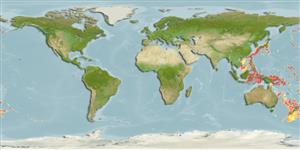Malacostraca |
Decapoda |
Geryonidae
Environment: milieu / climate zone / εύρος βάθους / distribution range
Οικολογία
; εύρος βάθους 300 - 1500 m (Αναφ. 343). Tropical
Western Pacific: Japan to Palau.
Length at first maturity / Μέγεθος / Weight / Age
Γεννητική Ωρίμανση: Lm ? range ? - ? cm Max length : 30.0 cm CW αρσενικό/απροσδιόριστο; (Αναφ. 343)
Carapace hexagonal; dorsal surface (especially branchial regions) distinctly inflated; anterolateral teeth low in adults. Merus of legs long, slender, with dorsal subdistal tooth; dactylus of legs laterally flattened, height at midlength less than width at midlength. Color: uniform tan to cream color overall.
Commands high prices of up to US$60 to US$80 for a fresh crab of 20 cm width. Inhabits soft substrates in deep waters (Ref. 343).
Life cycle and mating behavior
Γεννητική Ωρίμανση | Αναπαραγωγή | Γεννοβολία | Eggs | Γονιμότητα | Larvae
Members of the order Decapoda are mostly gonochoric. Mating behavior: Precopulatory courtship ritual is common (through olfactory and tactile cues); usually indirect sperm transfer.
Ng, P.K.L. 1998 Crabs. p. 1045-1155. In K.E. Carpenter and V.H. Niem (eds) FAO species identification guide for fishery purposes. The living marine resources of the Western Central Pacific. Volume 2. Cephalopods, crustaceans, holothurians and sharks. Rome, FAO. 1998. pp. 687-1396. (Αναφ. 343)
IUCN Red List Status
(Αναφ. 130435: Version 2025-1)
CITES status (Αναφ. 108899)
Not Evaluated
Not Evaluated
Threat to humans
Human uses
αλιεία: Εμπορικό(ά)
FAO - αλιεία: landings | FishSource | Η θάλασσα γύρω μας
Εργαλεία
Περισσότερες πληροφορίες
Τροφική ΟικολογίαFood items (preys)
Σύσταση δίαιτας
Κατανάλωση τροφής
Θηρευτές
Population dynamicsΑύξησηMax. ages / sizesLength-weight rel.Length-length rel.Length-frequenciesMass conversionΑφθονία Life cycleΑναπαραγωγήΓεννητική ΩρίμανσηΓονιμότηταΓεννοβολίαEggsEgg developmentLarvae PhysiologyΚατανάλωση οξυγόνου
Human RelatedStamps, coins, misc.
Διαδικτυακές πηγές
Estimates based on models
Preferred temperature
(Ref.
115969): 2.7 - 4.1, mean 3.4 (based on 414 cells).
Fishing Vulnerability
Low vulnerability (20 of 100).
Price category
Unknown.
